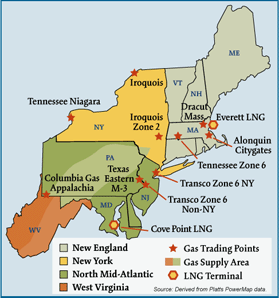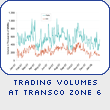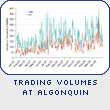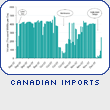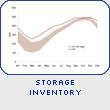| Market Description |
 Back to Top Back to Top |
-
Natural gas use is increasingly important to the Northeast. Though traditionally the Northeast has been a winter peaking region, increased reliance on natural-gas fired generation has evened out annual gas use. Increased dual requirements for natural gas as a space heat fuel and utilization of gas-fired plants has imposed greater challenges on the Northeast, compared to other regions, in aligning commercial and operating conditions between the gas and power industries. The Northeast has little indigenous production (mainly in the Appalachian basin) and none in New England. The Northeast relies upon conventional and LNG storage to meet peak-day gas needs. Despite increased gas use for power generation, pipeline utilization remains highly seasonal; major regional pipelines often operate at high load factors during the winter resulting in basis differentials to upstream liquid trading points that may greatly exceed firm transportation tariff levels. LNG plays a critical role in the overall supply mix and accounts for up to 30 percent of peak-day gas needs in New England. Market participants in the Northeast can draw upon the nation’s most extensive portfolio of dual, gas-oil fired power plants to flexibly respond to market price and load changes.
| Geography |
 Back to Top Back to Top |
-
States covered: Connecticut, Delaware, Maine, Maryland, Massachusetts, New Hampshire, New Jersey, New York, Pennsylvania, Rhode Island, West Virginia, and Vermont.
| Major Trading Hubs |
 Back to Top Back to Top |
-
Algonquin Citygates, Columbia Gas Appalachia, Texas Eastern M3,
Transco Zone 6 NY, and, Transco Zone 6 Non-NY.
| Storage |
 Back to Top Back to Top |
-
State Capacity: New York, Pennsylvania, and West Virginia accounted for 100 percent of total conventional storage capacity in the Northeast in 2005. New England has no conventional storage capacity, but it has about 18.4 Bcf of LNG storage capacity – 3.4 Bcf at the Everett terminal and the remainder at satellite storage locations throughout New England. New York and New Jersey add about 3.2 Bcf and 3.7 Bcf of LNG related storage capacity, respectively.
Aquifer Capacity: 0%
Depleted Field Capacity: 99%
Salt Cavern: 1%
Total Capacity: Northeast has 18 percent of total US storage capacity.
Major Storage Pipelines and Capacity:
Columbia System: 246 Bcf
Dominion:290 Bcf
National Fuel: 69 Bcf
| Demand |
 Back to Top Back to Top |
-
2005
- Residential: 38%
- Commercial: 21%
- Industrial: 33%
Sector:
State: New York, New Jersey, and Pennsylvania make up 68 percent of total Northeast demand and about 12 percent of total U.S. demand.
Northeast Total: 3.5 Tcf annually ( or 9.9 Bcfd) which makes up 18 percent of total U.S. daily demand.
Consumer Total: 14.4 million, which is approximately 21 percent of total consumers in the U.S.
Key Consuming States: New York, New Jersey, and Pennsylvania make up 71 percent of total consumers in the Northeast and about 15 percent of total consumers in the U.S.
Residential Consumers: 91%
| Production |
 Back to Top Back to Top |
-
State: Northeast gas production concentrated in Pennsylvania and West Virginia; together they account for 87 percent of total Northeast production. Nationally, however, these supplies equal about 2 percent of total U.S. production.
Total: Total Northeast production equals 0.4 Bcfd; it makes up 2 percent of total U.S. daily production.
Yearly Change: Northeast regional gas production in 2005 declined about 4 percent from 2004; much of this decline is attributable to declines in Pennsylvania production which declined 15 percent.
| Pipeline Flows |
 Back to Top Back to Top |
-
Average Daily Southern Zones Deliveries to the Northeast
2005: 6.9 Bcfd
2006: 6.6 Bcfd
Major Pipelines: Transco, Tennessee, Texas Eastern and Columbia carry a significant amount of gas from the Gulf coast to the Northeast.
Average Daily Mid-Continent Deliveries to the Northeast
2005: 1.6 Bcfd
2006: 1.6 Bcfd
Major Pipelines: Columbia, Texas Eastern and Dominion move gas from the Midwest to the Northeast.
| Imports and Exports |
 Back to Top Back to Top |
-
Average Daily Imports from Canada into the Northeast:
2005: 2.8 Bcfd
2006: 2.7 Bcfd
Major Importers: Maritimes and Northeast pipeline, Tennessee Gas Pipeline and Iroquois Gas Transmission System flow the majority of the gas from Canada to the Northeast. Together, they represent the following percentages of pipeline gas imports:
2005: 83%
2006: 85%
Average Daily LNG Send out:
2005: 0.3 Bcfd
2006: 0.3 Bcfd
Note: Represents daily receipts from Everett to Tennessee and Algonquin. Excludes volumes delivered via truck, consumed at Mystic or other distribution.




